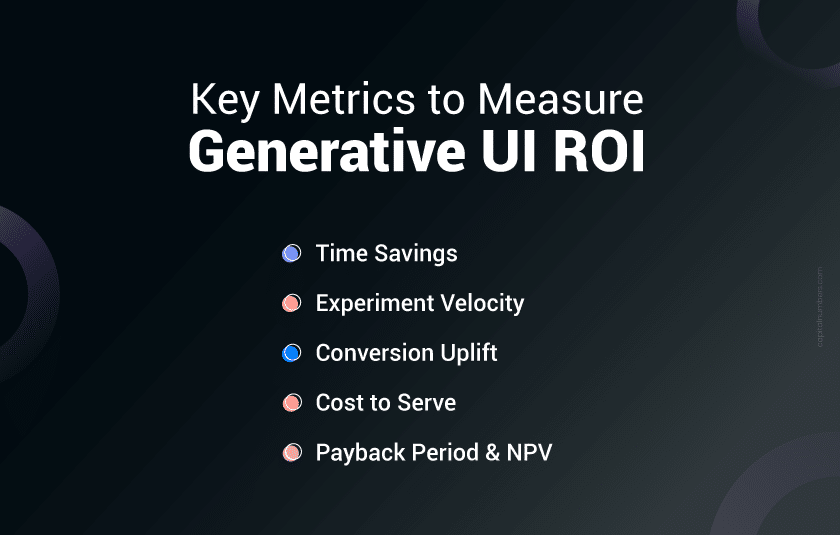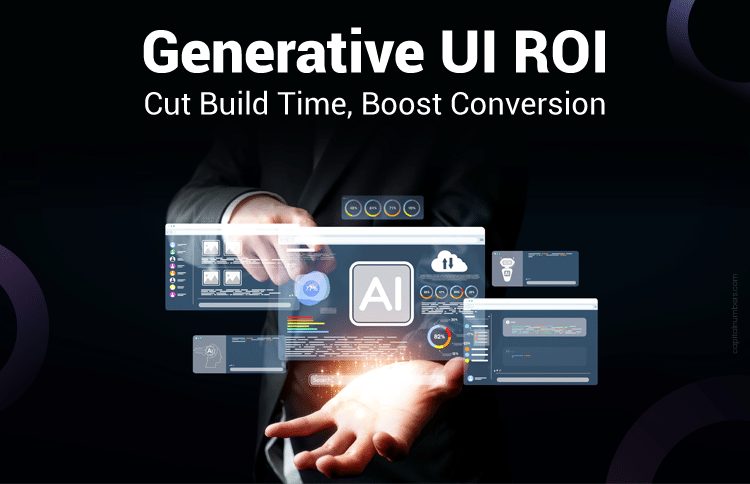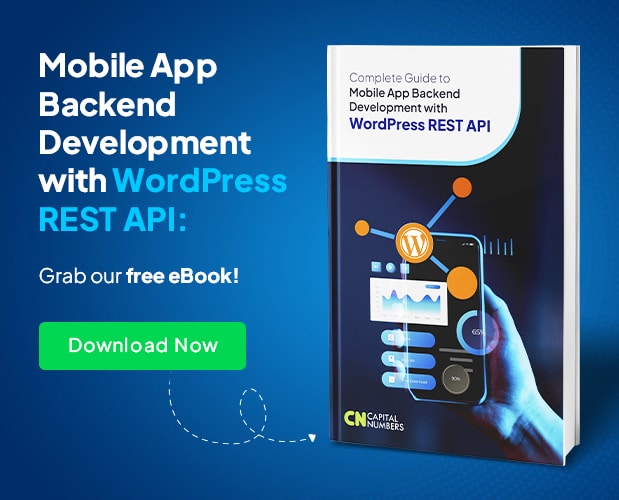Generative UI ROI: Cut Build Time, Boost Conversion
Table of Contents
Generative UI utilizes AI, particularly deep learning models, to help design and automate the coding of user interfaces based on defined rules, learned patterns, and preset parameters. You give the model a wireframe, design tokens, and constraints. It returns working components and layout suggestions that fit your brand and accessibility standards. Think of it as an assistant that speeds up the boring parts, while your team keeps control of quality, security, and UX.
This approach saves time and enables businesses to innovate faster. With generative UI, you can quickly adapt to trends, improve design processes, and create user-friendly interfaces. In this blog, we’ll explain how generative UI can reduce build times, increase conversions, and show clear ROI. Read on.
Why Generative UI Now?
With tight budgets and rising UX demands, businesses are under pressure to keep up. Traditional workflows often lead to delays, particularly with tasks such as handoffs and repetitive design work. With generative UI, which primarily applies machine learning models and AI techniques to automate aspects of UI design, businesses can automate repetitive tasks, allowing the team to focus on what matters most.
- Pressure: Lean budgets, high UX expectations, and too many experiments to handle.
- Bottlenecks: Delays from handoffs, repetitive tasks, and variant changes.
- Solution: Automate repeatable tasks and let designers and developers focus on important decisions.
- Impact: Faster design processes with AI-powered UI/UX solutions.
Scope and Limitations of Generative UI
Generative UI is changing how UI/UX designers and front-end developers work by changing the design and development process. However, it’s important to recognize its capabilities and limitations.
In-scope:
Generative UI automates various parts of UI/UX design, making workflows faster and more efficient.
- Prompt to Wireframe: Uses simple text prompts to generate wireframes or design layouts.
- Wireframe to Component: Automatically converts wireframes into reusable UI components.
- Token-guided Code Generation: Leverages predefined design tokens (e.g., color palettes, typography, spacing) to ensure consistency and streamline the creation of UI components.
- Copy/Layout Variants: Automatically generates variations of UI layouts and text for A/B testing and experimentation.
Out-of-scope:
Generative UI has its boundaries and does not handle everything.
- Core Domain Logic: Complex business processes, such as user authentication or payment systems, require human coding and decision-making.
- Sensitive Flows: User flows involving sensitive data, such as financial transactions, must be carefully managed and validated by developers to ensure security.
Where it fits in:
Generative UI integrates seamlessly into key areas of development:
- Design Systems: Ensures consistency across UI components and supports UI/UX design principles.
- CI/CD: Works well within Continuous Integration/Continuous Deployment pipelines, automating updates.
- Analytics: Gathers insights to improve UI performance and inform design decisions.
- Experimentation: Supports rapid A/B testing to help UI/UX designers make data-driven decisions.
To fully unlock the potential of generative UI, hiring frontend developers with experience in design systems and automation is essential. A skilled frontend developer can help integrate generative UI into your workflow, ensuring speed, consistency, and high-quality results.
ROI Framework for Generative UI: Key Metrics to Consider

Understanding the Return on Investment (ROI) for generative UI is crucial to fully grasping its potential in transforming UI/UX design processes. By focusing on key metrics – time savings, experimentation speed, conversion improvements, and overall costs – you can clearly see how this technology boosts efficiency and drives growth.
-
Time Savings
Generative UI automates the repetitive design and development tasks, giving your team more time to focus on high-leverage work. For example, if a feature typically takes 10 hours to design but now only takes 3 hours with generative UI, the time savings compound quickly. By calculating the hours saved per feature and multiplying them by how many features are built each month, you’ll see just how much more efficient your workflow becomes. For UI/UX designers and front-end developers, this means fewer hours spent on mundane tasks and more time to innovate.
-
Experiment Velocity
AI in UI design accelerates your experimentation process. With generative UI, creating different UI variants is automated, allowing for more tests and faster iterations. This speed helps you gather more data in less time, making it easier to find winning designs. For UI/UX designers, this means you can test new layouts and features more often, optimizing the user experience at a much quicker pace. The result? More informed decision-making, faster time-to-market, and a competitive edge.
-
Conversion Uplift
Generative UI is directly tied to improved conversion rates. With faster A/B testing and UI variant creation, you can quickly identify which designs resonate best with users. The quicker you can test and implement successful changes, the faster you will see conversion improvements (ΔCR). By automating these processes, you enable AI in UX to help you fine-tune designs in real-time, driving higher engagement and boosting revenue – all while ensuring that results are statistically reliable.
-
Cost to Serve
While generative UI offers significant value, it’s important to consider its associated costs. These include expenses for machine learning models (e.g., AI licensing or custom development), runtime resources (e.g., cloud infrastructure and GPU usage), and the potential increase in app bundle size, which could affect performance. Additionally, some rework may be needed if automation doesn’t perfectly align with design requirements. Understanding these factors helps determine whether the investment in generative UI is sustainable and cost-effective in the long run.
-
Outputs: Payback Period and NPV
The ultimate goal of any ROI framework is to determine the payback period – the time it takes to recoup your investment. With generative UI, businesses typically see payback within 12 to 24 months, depending on the scale of implementation and efficiency gains. Smaller startups or businesses with simpler UI/UX needs may achieve ROI faster due to lower investment and quicker implementation. In contrast, larger enterprises with complex requirements may experience a longer payback period as they scale across teams or projects. By calculating the Net Present Value (NPV) of future savings, companies can understand the long-term value Generative UI brings. This financial evaluation helps decision-makers assess if the investment is worth it and how quickly they can expect to see returns.
Get comprehensive UI/UX design services from Capital Numbers to create visually stunning, user-friendly designs that enhance user engagement and satisfaction. Our experts specialize in building intuitive, responsive, and scalable interfaces tailored to your business needs. Let’s bring your ideas to life with exceptional design.
A Template for Calculating Generative UI ROI
To estimate the ROI of implementing generative UI, use the following template to calculate time savings, revenue from improved conversions, and tooling costs, ultimately determining the net benefit and payback period.
Inputs:
- Baseline Hours vs. GenUI Hours: The number of hours it typically takes manually (baseline) vs. with generative UI (GenUI).
- Hourly Rate: Cost per hour for your team (UI/UX designers, front-end developers).
- Pages/Tests per Month: Number of pages or tests generated and run each month.
- Revenue Tied to Surface: Revenue associated with the pages or tests being optimized.
- Baseline Conversion Rate (CR): Current conversion rate before using generative UI.
Calculations:
- Time Savings ($):
Calculate time saved per page/test by subtracting GenUI hours from baseline hours.Formula: Time Savings = (Baseline Hours – GenUI Hours) × Hourly Rate × Pages/Tests per Month
- Incremental Revenue from ΔCR:
Estimate the revenue boost from improved conversion rates (ΔCR).Formula: Incremental Revenue = Revenue per Page × (New CR – Baseline CR)
- Tooling Costs:
Account for costs of implementing generative UI (model costs, software, licensing). - Net Benefit:
Subtract tooling costs from time savings and incremental revenue.Formula: Net Benefit = (Time Savings + Incremental Revenue) – Tooling Costs
- Payback Period:
Calculate how long it will take to recover the initial investment.Formula: Payback Period = Tooling Costs / Net Benefit
This simple ROI framework helps you evaluate the financial benefits of generative UI, including time saved, increased revenue, and the costs involved, empowering you to make data-driven decisions for your UI/UX design process.
High-Impact Use Cases for Generative UI
Generative UI enhances your business by driving efficiency, improving customer experiences, and streamlining operations. Here are key use cases where it adds value:
1) E-commerce
Generative UI helps you quickly optimize your e-commerce platform for better user engagement and higher conversions.
- PDP/PLP Variants: Automatically generate and test different product page layouts, improving discoverability and sales.
- Checkout Microcopy: Generate engaging microcopy for checkout processes to reduce cart abandonment.
- Promos: Dynamically create promotional banners and CTAs based on offers or inventory.
2) Acquisition
Accelerate customer acquisition by optimizing landing pages, CTAs, and lead forms.
- Landing Pages: Create personalized landing pages that speak directly to different audience segments.
- Hero Sections: Quickly test variations of headlines, visuals, and CTAs to boost engagement.
- Lead Forms: Experiment with form layouts to increase sign-ups and conversions.
3) Onboarding & Product
Enhance the onboarding process and guide users efficiently with generative UI.
- Tours: Create interactive onboarding tours to help users get up to speed quickly.
- Empty States: Automatically generate personalized prompts when no data is available, encouraging engagement.
- Forms: Streamline form creation for sign-ups, profile updates, and feedback.
4) Internal Tools
Generative UI makes creating internal tools faster and more efficient.
- Dashboards: Automatically generate customized dashboards with key metrics and data.
- CRUD Screens: Quickly generate CRUD (Create, Read, Update, Delete) screens for managing business data.
With generative UI, businesses can save time, reduce manual tasks, and create more personalized experiences – whether for customers or internal teams. Automating key aspects of UI/UX design, it drives efficiency and growth across all areas of your business.
Performance and Cost Control in Generative UI
When implementing generative UI in UI/UX, it’s crucial to optimize for performance and cost efficiency. You should make sure that your application is fast and scalable, while managing resource usage effectively. It can lead to better user experiences and lower operational costs. Here are the key strategies to control performance and costs effectively.
Rendering
- Server-first (RSC/SSR): Render on the server for faster first paint, lower TTI, and better SEO.
- Client islands: Hydrate only what’s interactive; keep the rest static for lighter pages.
Assets
- Responsive images: Right size per device; no overserving.
- AVIF/WebP: Smaller files, same quality.
- Font subsetting: Ship only the glyphs you use.
JS Budgets
- Import boundaries: Code-split by route/feature; avoid shipping the whole app at once.
- Dead-code checks: Strip unused modules regularly to keep bundles slim.
LLM Cost (for Generative UI)
- Cache by prompt/wireframe hash: Reuse identical outputs; cut API calls.
- Spend caps + telemetry: Set limits, track usage, and tune prompts/models over time.
By following these strategies, you can ensure that your generative UI implementation delivers fast, efficient, and cost-effective experiences for your users.
Build vs Buy vs Hybrid: Choosing the Right Approach for Generative UI
When deciding how to implement generative UI in your existing UI/UX design system, organizations often face a crucial decision: should they buy a solution, build it in-house, or go for a hybrid approach? Each option has its advantages and trade-offs, and the right choice depends on several factors such as speed, control, cost, and specific business needs. Below is a breakdown of each approach, along with a decision matrix to guide your choice.
When to Buy
- Fast start: Launch quickly with a proven engine; minimal setup.
- Supported: Updates, fixes, docs, and SLAs are handled.
- Trade-off: Vendor lock-in and limited deep customization.
- Best for: Teams without in-house capacity who need results now.
When to Build
- Full control: Architecture, prompts, guardrails, and integrations your way.
- On-prem privacy: Keep sensitive data in your environment.
- Trade-off: Higher upfront cost, longer time to value, and ongoing maintenance.
- Best for: Regulated orgs and mature platforms with strong engineering depth.
When to Go Hybrid
- Balanced: Use a vendor for generation, keep your own DS/CI guardrails.
- Flexible: Your tokens, patterns, and checks; vendor speed where it counts.
- Lower lock-in: Easier to swap parts later.
- Best for: Teams with a solid UI/UX design system who want both speed and control.
Key Factors to Consider
- Data residency & privacy: GDPR/HIPAA or strict client rules → Build or Hybrid.
- Design system maturity: Strong DS and tokens → Build/Hybrid. New or light DS → Buy.
- Budget & runway: Tight budget/timeline → Buy. Strategic investment → Build/Hybrid.
- Team skills: Limited GenUI/LLM expertise → Buy/Hybrid. Deep skills → Build.
Quick Chooser (Rule of Thumb)
- Need value in weeks, not months? Buy.
- Need deep customization and on-prem control? Build.
- Need speed now but control later? Hybrid.
Pick the model that meets your requirements. With the right choice, artificial intelligence in UI design becomes a scalable advantage. It will help UI/UX designers and front-end developers ship faster, stay consistent, and boost conversion.
Implementation Checklist for Generative UI
Following a comprehensive checklist helps you ensure a smooth and successful implementation of generative UI. Here is the checklist to follow:
Wireframe Spec (YAML/JSON)
- Keep one spec in the repo, with a schema you can validate.
- Map every part to your design tokens/components; note ARIA and keyboard paths.
- Have the design and front-end developers review it together so you catch gaps early.
Prompt Templates & Few-Shot
- Version your templates (semver), store prompt hashes, and keep a short changelog so you know what changed and why.
- Refresh a few-shot “bad vs good” examples so the model learns your tokens, ARIA rules, and voice.
- Keep prompts next to your UI/UX design system so you can roll back fast if needed.
CI Gates
- Turn on TS strict, ESLint, and formatting so you don’t fight avoidable bugs later.
- Add Axe to CI with pass thresholds, so accessibility issues stop the merge, not the user.
- Use visual diffs on key screens to spot sneaky UI breaks.
- Set bundle budgets per route; if you blow the budget, you fix it before merging.
- Cover generated components with unit/integration tests so you trust changes.
PR Template
- Write acceptance criteria (what’s done, why it matters).
- Drop the experiment link or flag ID (A/B, rollout %), so anyone can track results.
- Attach screenshots or Storybook links plus the visual-diff URL.
- Note accessibility details (tab order, focus traps).
- Include a rollback plan and a clear owner, so you’re never stuck.
Dashboards
- Efficiency: Track lead time, cycle time, and how much was auto-generated, so you see real time saved.
- Quality: Watch a11y scores, error rates, and visual regressions, so you keep shipping clean.
- Growth: Tie changes to conversion, engagement, and retention, so you know it moved the needle.
- Cost: Monitor LLM spend per PR and cache hit rate, so generative UI stays efficient.
This checklist helps align teams, maintain high-quality standards, and track the impact of the generated UI on user engagement and business outcomes.
Bottom Line
By implementing generative UI, you’re not just saving time; you’re creating smarter, more effective user experiences. With AI in UI design – and advanced generative AI development services, you can cut development cycles, maintain consistency, and ultimately improve conversion rates. By automating design tasks and optimizing workflows, your team can focus on what matters most -delivering exceptional results.


















